“Mario Kart Tour’s” Explosive Popularity
BREAKOUT MOBILE “MARIO KART.” Fan favorite “Mario Kart” comes to mobile in the form of long awaited “Mario Kart Tour,” breaking several records upon its blowout debut.
October 30, 2019
The world of mobile gaming had a big splash on Sept. 25 with the release of the long awaited “Mario Kart Tour” game, available on IOS and Android. The fan-favorite Nintendo game was released to phones worldwide and it immediately made a major impact on the app store. On the day of its debut, the game had a little over 10 million downloads globally, making it one of the most successful mobile game releases to date, even beating out app store giants like “Pokemon Go” and “Clash Royale.”
The massive success of the game is not a fluke either. The game has been received very well by downloaders such as Thomas Wilder, an author for Geek Wire (a news website dealing in all things technology and business) who reports, “I was never a big fan of ‘Mario Kart’ on consoles, or racing games in general, so I was surprised by how much I initially liked ‘Mario Kart Tour.’ It’s a simpler, more accessible free-to-play version of classic ‘Mario Kart’ racing, made for iOS and Android, and it works much better than I thought it would.” This acceptance of the game by even “Mario Kart’s” critics shows how well it has been received in the mind of consumers.
The attraction that the newly released game holds is no mystery. When asked about the game’s major success upon its debut, junior Richard Martin says, “‘Mario’ is just such a culture thing, you can’t go far without seeing it so whether or not you played it before, you know what it is and in that way its attractive, which definitely helps boost the downloads.” Martin brings up a great point, including how much the “Mario” franchise has been intertwined with so many young generations of people that the pure energy of nostalgia pulls people in. Sophomore Veeti Alato expands on the idea of nostalgia and the pull it has on consumers, saying, “I think [the game is successful] because every age demographic, except maybe people over 40 have at least tried the game so they might think, ‘Oh, I haven’t played ‘Mario Kart’ in a long time, I should try that.’”
This opinion of “Mario Kart Tour’s” success being largely attributed to the nostalgia the franchise brings certainly has truth, but it is not the sole factor.
Even before its release, “Mario Kart Tour” was growing in popularity as its creator Nintendo heavily advertised the game to the public, even to the point of partnering with Apple to get it more advertisement time within the Apple app store. According to Venturebeat, a technology news website, this allowed the game to be viewed by a much larger audience, getting it the publicity it needed for such a substantial launch. “Mario Kart Tour” was also available for pre-order, which would automatically download the game upon its release. This boosted first day sales greatly, and with the accumulation of mass marketing, accessibility, and nostalgia, it is no wonder why the game had such a triumphant debut.
The layout and controls of the game are relatively simple. As detailed in a review by Michael McWhertor from The Polygon, the game features all of the fan-favorite characters from the “Mario” franchise along with the same system of stylization that was beloved in the console version. The controls are based on the phone’s unique ability to swipe anywhere on the screen. To go left or right, it is a simple matter of swiping in either direction, and to release one of “Mario Kart’s” many weapons, it is all just a swipe up or down—easy to learn, but hard to improve upon. The layout of the game is unique to the mobile version as well, the game runs on its name and provides weekly “tours” which are a collective set of “cups” or series of four separate races. With four races per cup and around fifteen cups per weekly tour, there is no lack of gameplay available, which will keep players coming back for more.
When asked about their initial reactions to the game, a large majority of people pointed out some common flaws within the game. This included how the microtransaction monetary system leaves much to desire and how the controls are too easy. Senior Gaje Gunter comments on the controls by saying, “At first, I thought it was kind of difficult to play, but once I got the hang of it, it was actually pretty easy and once I started playing more, I found that it was harder to get good at it, like you can’t really improve so you stay stationary.” So while the game is fun, there is no way to improve in skill once you get to a certain point, unlike its console counterpart which needs more control and skill to be consistently number one. A prevalent issue was the fact that the game did not quite measure up to the console version, which caused a slight disappointment. That disappointment did not last long, however, as the game at its core has been justifiably watered down to fit into a mobile version so it is actually playable. This transition from console to mobile came at the price of some of the original gamestyles, but it is largely agreed that Nintendo did the best they possibly could with these constraints and still managed to create a very entertaining game.
Another glaring issue is the fact that while the game advertises as multiplayer, as of right now, it is not. The multiplayer option has yet to be implemented into the game, even if it may seem like it in the races, but in reality those opponents in the game are actually computer generated artificial intelligence that are built to race against you. However, the lack of multiplayer is not the problem, as explained by Dave Thier, an author for Forbes Magazine, “The problem here is that many of the game’s core systems, like characters that get extra items or the entire scoring system, just don’t really play well in a competitive multiplayer context, even if it’s only as competitive as ‘Mario Kart’ ever is. You’d have to mostly do away with score, or at least make it irrelevant.” A crucial issue may lie in the addition of multiplayer, but Nintendo will have to learn as they go with this game and hopefully abide to what the fans want.
An issue that may prove tricky with Nintendo is the game’s monetary system. The game has an in-game shop with an abundance of items that can be used as you progress through the game, but it is unfavored by many because of the involvement of real money. This form of profit is known as microtransactions, a new form of marketing that is becoming more and more popular with new games. While the game is initially free, there are lots of things in-game that can be purchased with real money. While some see it as a good system that allows more people to play the game, some see it in a different light. Alato sees it as a suffocating money-grab by Nintendo, but admits that the microtransaction system has been wildly successful in games such as “Fortnite” and makes sense from an economic standpoint, despite his personal preference. While the preferences of the player base concerning additional in-game content is divided, it is agreed that the game is becoming more and more successful as it goes along, with more content being released each week.
As far as the longevity of this game, the future seems hopeful. Freshman Colin McBride compares it to “Pokemon Go” in terms of continued popularity, “I think it’s gonna last a little bit longer than ‘Pokemon Go’ did because the reason ‘Pokemon Go’ died off was because there wasn’t a lot of new stuff being added to the game and people got tired of waiting for it, but ‘Mario Kart’ gives new races weekly and adds more characters and maps. Basically a [continuous] flow of content.” He also believes that once the multiplayer feature is added, the player base will boom as friendly competition within the game reaches its height and as playability increases. The download rate has already seen a heavy dip, but with constant new editions coming every week, the future of “Mario Kart Tour” seems very hopeful and only time will tell if the possible problems it faces will submerge it.




